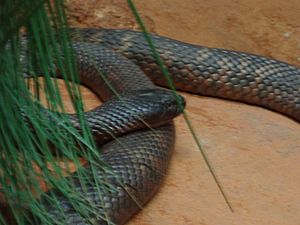Collett's snake facts for kids
Quick facts for kids Collett's snake |
|
|---|---|
 |
|
| Scientific classification | |
| Genus: |
Pseudechis
|
| Species: |
colletti
|
The Collett's snake (Pseudechis colletti) is a type of venomous snake. It is also known as the Collett's black snake or Down's tiger snake. This snake lives in Australia. Even though its venom is not as strong as some other Australian snakes, its bite can still be very dangerous. It is known as one of the world's most venomous snakes.
Contents
About Collett's Snake
Collett's snake is part of a group of snakes called Pseudechis. These are often known as black snakes. Scientists have studied its DNA. They found it is most closely related to the blue-bellied black snake. The Papuan black snake is its next closest relative.
A scientist named George Albert Boulenger first described this snake in 1902. He named it after a Norwegian zoologist, Robert Collett. Collett had found a young snake. Boulenger noticed its unique scale pattern. This pattern was different from the Papuan black snake.
What Collett's Snake Looks Like
Collett's snake is one of the most colorful black snakes. Its top side is dark brown to black. It has pink or cream bands and sides. Its belly is usually pale yellow or orange. The bands on its body are often shaped like a cross. They are usually an orange-red color. The belly is often the same color as the bands. Sometimes it has different colored spots.
Young Collett's snakes look like the adults. But their colors are often brighter. They also have more contrast. This snake looks similar in shape to the red-bellied black snake. However, their colors are very different.
Collett's snakes usually grow to be about 1.8 to 2.2 meters (about 6 to 7 feet) long. Male snakes can be longer, up to 2.6 meters (about 8.5 feet). Females are a bit shorter, up to 2.1 meters (about 7 feet). When they are born, they are about 30 centimeters (about 1 foot) long.
Understanding Collett's Snake Venom
At first, people thought the venom of Collett's snake was not very strong for humans. But now we know it can cause serious problems. Its venom can damage muscles and kidneys. The effects are similar to the venom of the mulga snake.
If someone is bitten, they might feel sick. They could have nausea, vomiting, stomach pain, or a headache. The venom can also affect blood clotting. It can cause muscle damage and kidney problems within a day. It is important to get medical help quickly. Doctors can give special antivenom.
Even though its bite is dangerous, many people like to keep Collett's snakes as pets. This is because of their beautiful markings.
The venom of Collett's snake is like that of the Papuan black snake and the mulga snake. It can harm cells and blood. It might also contain poisons that affect the nervous system. A Collett's snake can release about 30 milligrams of venom in one bite. Doctors can use black snake or tiger snake antivenom to treat bites. This snake is considered the nineteenth most venomous snake in the world.
Where Collett's Snake Lives
Collett's snake lives in central western Queensland, Australia. It is active during the day. You can mostly find it in the western parts of Queensland. Its home range spreads from north to south. It prefers dry, open areas or plains.
How Collett's Snake Behaves
What Collett's Snake Eats
Collett's snakes mainly eat amphibians, reptiles, and small mammals. Sometimes, these snakes will even eat other Collett's snakes.
How Collett's Snake Reproduces
Collett's snakes mate from early August to late October. The female snake lays eggs. She can lay up to 20 eggs at one time. It is known that these snakes can have babies successfully when they are kept by humans.
See also
 In Spanish: Serpiente negra de Collett para niños
In Spanish: Serpiente negra de Collett para niños

